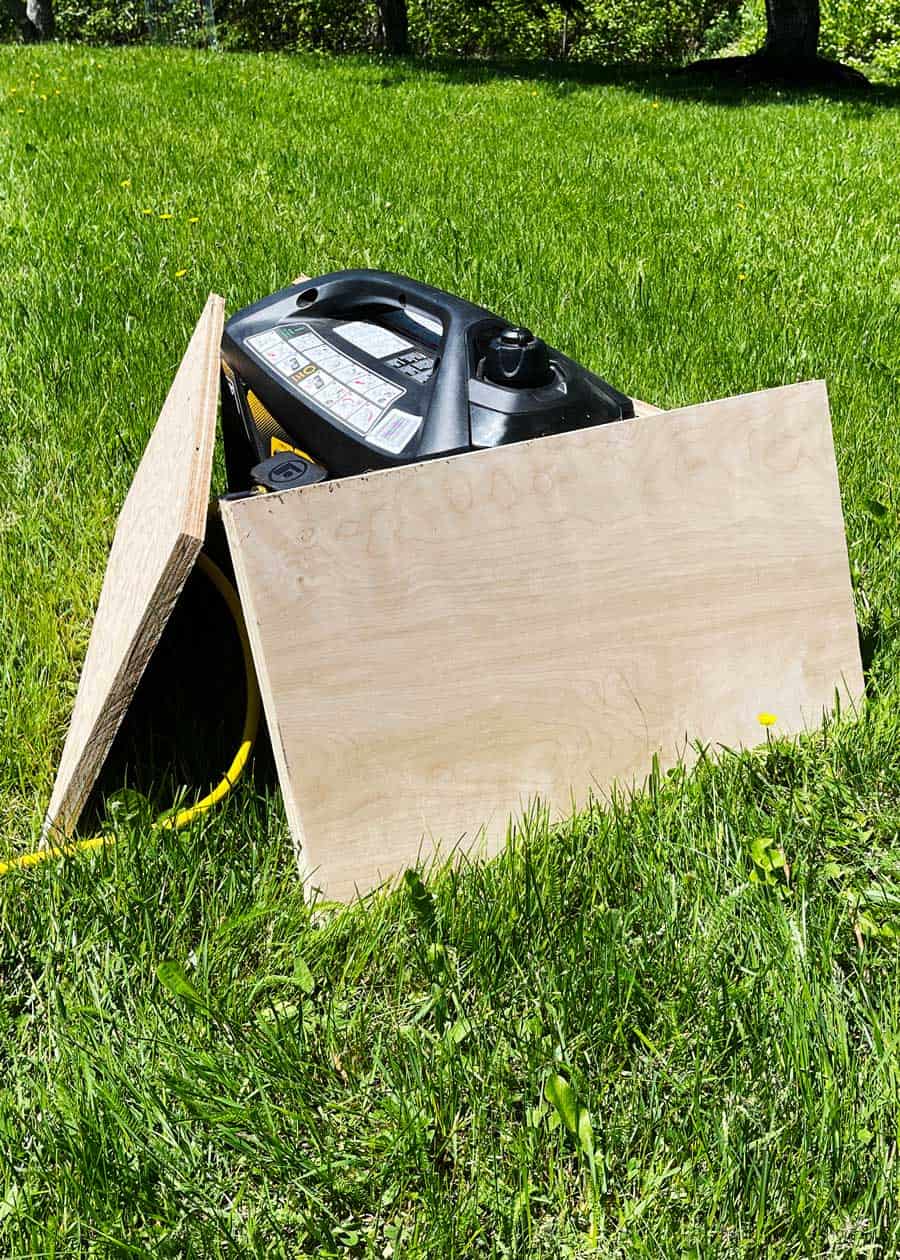How to Quiet a Generator: 9 Easy Tips for RVers & Campers
Imagine the scenario: You start your generator and notice that it is louder than you remember. To avoid a noise complaint from other campers, you’re trying to silence your generator. In this guide, you’ll learn how to make a generator quiet.
Here’s how to quiet a generator: Place your generator on a soft location (like grass), use sound deflectors, use a water muffler, or reposition the generator location. You can also build a simple enclosure box or purchase another muffler to help lower the noise your generator produces.

There are many ways to quiet a generator while keeping a budget. These tips are inexpensive and quick. You can even use a few of them at the same time.
Here are nine tips for soundproofing a generator while camping.
How to Make a Generator Quiet: 9 Tips
Gas generators can range from 50 dB to 100 dB. The National Institute on Deafness and Other Communication Disorders says that if your ears hear 85 decibels continually, it can cause hearing damage or loss.
Protect yourself and your family from hearing damage by using one or more of these tips to reduce noise output from your camping generator.
The following tips will show you how to make a generator quiet.
1. Find a Softer Location to Sit the Generator
Place your generator on a softer surface at your campsite to muffle the noise. Set it on grass or a dirt patch for a quick fix.
One study (citeseerx.ist.psu.edu) showed that a 1.25″ (32 mm) sand bed underneath a generator lowered noise output by 10 dB.
Just moving it from asphalt to grass will help – by allowing the lawn to absorb some sound and vibration fo the generator.
Here is my generator set up on the grass.

2. Anti-Vibration Pads
Anti-vibration pads are a quick fix to quieting a generator. Place one pad under each corner of the generator. The durable foam padding will raise the generator from the ground and muffle the noise emitted.
When a generator is on a hard surface, it reflects the noise into the environment. Using anti-vibration pads can help absorb vibration and noise, making it quieter.
A set of anti-vibration pads, like these rubber and cork ones, can do the trick. They come in a pack of 4 and are 7/8″ thick.
Or you could use a large mat that goes under the whole generator. Like this 24″ x 36″ pad made of 1/8″ neoprene rubber. For most camping-sized generators (like mine), you can probably double it over and get double thickness.
3. Build a Generator Enclosure Box
Construct your enclosure box with soundproof materials such as acoustic plywood or acoustic foam board.
Follow these steps to construct the box:
- Note the generator’s dimensions on the generator’s product box.
- Add about 1-1.5 feet to the dimensions for the enclosure box’s sides so there is room to place the generator in the area and remove it when needed.
- Purchase acoustic foam board or plywood
- Don’t forget to seal the seams
- Gorilla glue or E6000 to join acoustic foam board edges.
- PVA wood glue for the plywood edges.
- Construct the box.
- Leave sufficient ventilation for intake and exhaust
While this is a good idea for a permanent setup, an enclosure box is less than ideal if you frequently travel with your RV. It is large and will be heavy.
For an effective, more flexible alternative, check out the next quieting method.

4. Use Plywood for Sound Deflecting
If you don’t want to construct the DIY enclosure box, you can still soundproof a generator with the same acoustic plywood.
Prop up pieces of plywood around the generator to achieve the soundproof effect. This method can result in a 10db reduction in sound – see video below.
This is a great method for RVers because the plywood stacks flat when traveling, requiring much less space than a built enclosure.
For safety, you’ll need to be careful with plywood around the exhaust pipe. I’ve seen a partial sheet of sheetrock used on the exhaust side because it won’t catch fire.
If you aren’t careful, a fire could start if wood or another flammable material is too close to the exhaust. Also, you need to keep a good angle on the plywood, so there is sufficient airflow.
Here’s a video showing a 10db reduction in sound, using the plywood method. The demo starts just after the five-minute mark.
Want to dump your RV waste at home? Here are 9 things to know.
5. Reposition the Generator
A simple way to quiet a generator is to reposition the generator and how it faces your campsite. The exhaust pipes are where much of the noise originates, so if you point that area towards your campsite, there will be noise disturbances.
Set the exhaust pipes to face away from the campsite so the noise goes the opposite way.
You can also check your manual and see if your generator model allows you to reposition the exhaust pipe so that it points upward rather than downward.
Either of these methods will lower noise output.
These skills can be especially helpful when stealth camping.
6. Don’t Buy Larger Than You Need
One of the best ways to make a generator quiet is to purchase a generator based on your power needs at your campsite.
A 2,000-watt generator can help you charge smartphones, keep a fridge on, and put lights on in your camper. If these are your basic needs, then you will have the quietest portable generator on the market. Here’s a guide to choosing a generator by Consumer Reports.
Lower wattage often means there will be less noise generated.
But once you get into the large generators, they may actually become quieter. If you purchase a generator from 3,500 watts to 7,500 watts, they may come with built-in muffling features, which will cost more than the average model.
A drawback to these large generators is that they aren’t portable for camping and RVing.
Read More: How Does an RV Fridge Work?
7. Put the Generator Further From Your Campsite
Putting distance between your campsite and your generator will reduce the noise you hear. It’s a good idea to place the generator 20 feet or more away from your site within your line of sight.
To make this work best, you’ll need a longer power cable to run from your generator to your site.
While the generator will echo when sitting farther away from your campsite, the noise will not be as disturbing. This tip is most beneficial if camping sites are farther apart. If campsites are too close together, you may want to use another soundproofing method to avoid disturbing your neighbors.
Of course, you’ll want to avoid placing your generator in the woods, where it could ignite a fire.
8. Use Water in a Bucket
Water absorbs sound thanks to its molecules turning sound into heated vibrations. This is why you can hardly hear when someone is talking underwater in a pool.
- For this method, you will need a 5-gallon bucket full of water, a hose, and some clamps.
- Fill the bucket with the water. Place one end of the hose into the water and put the other end into the generator’s exhaust pipe.
- This needs to be done carefully to avoid water entering the engine. Some campers put small holes in the hose, to help prevent water from drawing back up the hose.
- Also to keep the water in the bucket, it makes sense to keep your generator at a higher level than the water level in the bucket.
The noises from the exhaust pipe will transfer into the water bucket rather than into the environment causing noise disturbances.
What Type of Hose? I haven’t personally used this technique, but I’ve read that some RVers use standard rubber hoses. This seems like a bad idea because the exhaust from the generator is hot. If I was going to try this, I would look for a metal option that I could clamp on the exhaust.
9. Add a Muffler
When all else fails, you might consider adding a muffler for quieting your camping generator. The generator’s exhaust pipes are responsible for much of the noise as the machine operators. And a muffler might help to quell the noise.
A NASA case study on controlling noise acoustics found that replacing the muffler on a pump machine reduces noise output by 24 dB. For a generator, muffler replacement can reduce noise output by an average of 10 dB.
It won’t be easy to find a muffler for a portable generator. You’ll probably have to modify a muffler from another engine. And it will likely lower the power output of the generator.
But if you have some technical ability and don’t mind a loss of engine power, this might be worth looking into.
You might also enjoy: How to Ground a Generator When Camping

Keep Reading: How to Heat a Camper Without Electricity: 6 Easy Ways
Before You Set up Camp
Test out which method will work best for your model. Try a few different procedures from this list while you are still at home planning your trip. This way, you will know how to soundproof your generator and have one less thing to worry about when setting up camp.






